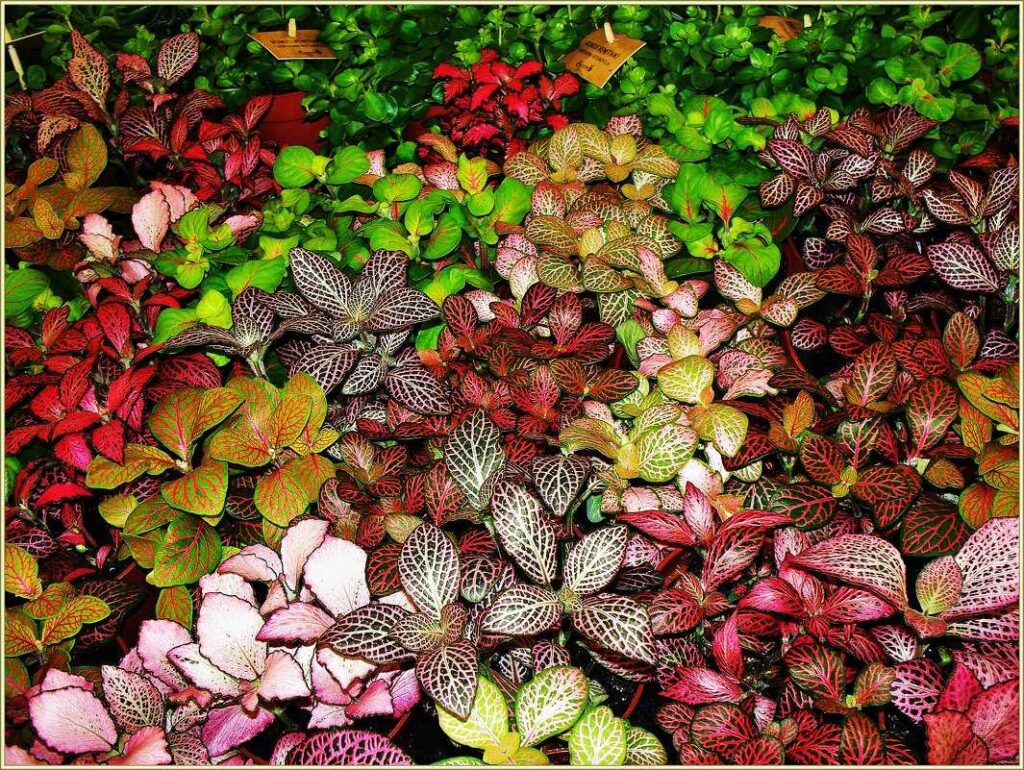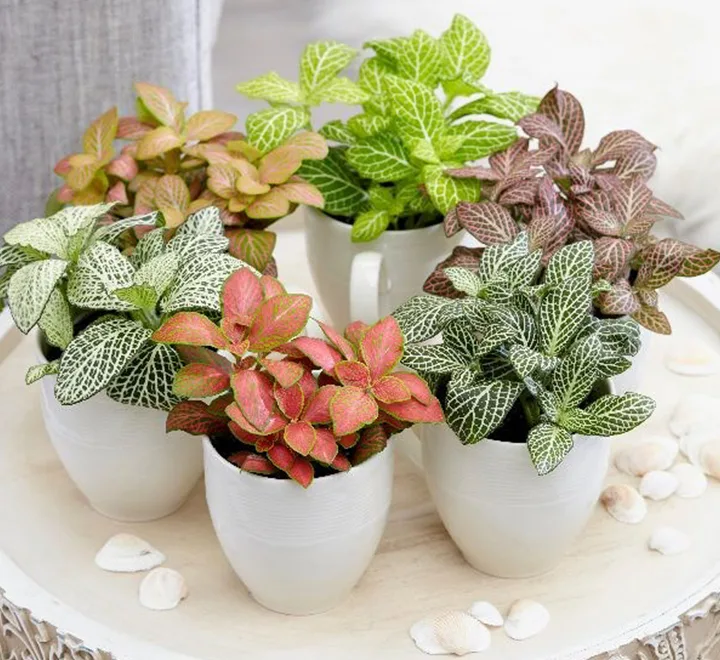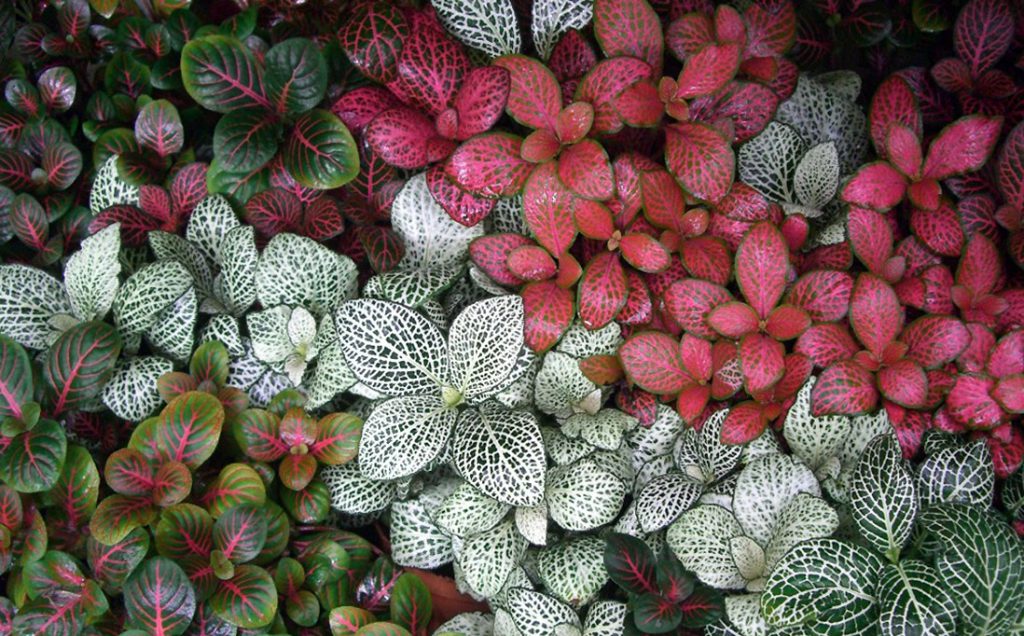The Fittonia, also known as the “Mosaic Plant”, is a true masterpiece of nature, with its richly colored leaves and distinctive patterns reminiscent of a work of art. Originally from the rainforests of South America, it is a highly prized indoor plant for its stunning appearance and relatively easy care. Its leaves in vibrant shades of green, pink, white and red form a unique mosaic, adding a touch of elegance to any space. In addition to its aesthetic beauty, phytonia is also known for its air-purifying properties, making it a popular choice for indoor environments.
Introducing
Fittonia belongs to the Acanthaceae family and is famous for its strikingly colorful leaves. From varieties with predominantly green leaves and colored veins to those with almost entirely pink leaves, it is a plant that catches the eye and arouses interest. Its compact growth makes it suitable for vases and hanging baskets, and it is a popular choice for those who want to add a touch of color and liveliness to their indoor spaces.
index
Meaning
In addition to its aesthetic beauty, Fittonia also carries an intriguing symbolic meaning. Its name “Fittonia” comes from the Greek word “phyton”, which means plant. This association with nature and the plant kingdom underscores Fittonia’s connection with the vitality of the earth. In addition, the mosaic appearance of its leaves can be seen as a representation of the diversity and complexity of life. This unique plant reminds us of the richness and variety present in the natural world and invites us to appreciate beauty in the most unexpected forms.
| Common Name | Mosaic Plant |
| Botanical Name | Fittonia spp. |
| Family | Acanthaceae |
| Type of Plant | Interior plan |
| Adult size | Usually 15 to 30 cm high |
| Solar Exhibition | Bright to medium indirect light |
| Soil Type | Well-drained soil rich in organic matter |
| Soil pH | Slightly acidic to neutral (pH 6.0 – 7.0) |
| Flowering Season | Varies, often in spring and summer |
| Color of Flowers | Generally small and discreetly colored |
| Native Area | South America, tropical regions |
| Toxicity | Slightly toxic if swallowed |
This information provides an overview of the characteristics and care required for Fittonia, allowing you to cultivate and enjoy this beautiful indoor plant.

Essential care
Fittonia, with its vibrant leaves and unique patterns, is a charming plant that deserves special attention to maintain its exuberance. Mastering essential care will ensure that your plant flourishes and continues to display its mosaic spectacle. Let’s explore each aspect of care that this exquisite plant requires:
Light
Light plays a crucial role in the healthy development of Fittonia. Here are some tips on how to provide ideal lighting:
- Bright Indirect Light: Avoid intense direct sunlight as this can damage the sensitive leaves of Fittonia.
- Medium light: Fittonia also thrives in areas with medium light, such as near a window with a light curtain.
Suitable Soil and Watering
The soil and water are essential for the well-being of Fittonia. Follow these guidelines to take care of these aspects:
- Well-Drained Soil: Use soil that allows good drainage to avoid water accumulating around the roots.
- Regular Watering: Keep the soil slightly moist, but not soggy. Avoid the soil becoming completely dry between waterings.
Controlled Temperature and Humidity
Phytonia thrives in specific temperature and humidity conditions:
- Temperature: Keep the plant in a temperature range between 18°C and 24°C to ensure healthy growth.
- Suitable Humidity: Fittonia appreciates higher levels of humidity. If the air is dry, consider using a humidifier or placing the plant on a tray of water.
Fertilizing for Nutrition
Fertilization is essential to provide the necessary nutrients for Fittonia:
- Regular Fertilization: During the active growing season (spring and summer), apply a balanced fertilizer every 4-6 weeks.
- Appropriate dilution: Follow the instructions on the fertilizer label to avoid over-fertilization.
By following these guidelines for light, soil, water, temperature, humidity and irrigation, you will be creating an environment conducive to Fittonia displaying its mosaic leaves in a lush and healthy way. Monitor your plant regularly and make adjustments as necessary to ensure that it continues to thrive in your indoor space.

Pruning: importance and techniques
Pruning is an important practice for maintaining the health and beauty of the Fittonia, as well as encouraging lush growth. Here are some reasons why pruning is essential:
- Removing Damaged Leaves: You can remove wilted, yellowed or damaged leaves to improve the overall appearance of the plant.
- Stimulating New Growth: Gentle pruning can stimulate the growth of new shoots and branches, making your Fittonia denser.
Pruning techniques
Aqui estão algumas técnicas de poda a serem consideradas:
- Removing wilted leaves: Cut off wilted or yellowed leaves close to the base of the plant.
- Tip Trimming: To encourage lateral growth, trim the tips of the stems just above a healthy knot.
Propagation methods
Propagating Fittonia allows you to share the beauty of this plant with other corners of your space or with friends. Here are some common propagation methods:
- Clump division: During transplanting, carefully divide the plant’s clumps, ensuring that each section has healthy roots.
- Stem Cuttings: Cut off a healthy portion of the stem, soak it in water until it develops roots and then plant it in the ground.
Step by step on how to plant
Planting Fittoniarequires attention to detail to ensure a successful establishment. Follow this simple step-by-step guide to planting your Fittonia:
- Pot choice: Choose a pot with drainage holes and the right size to accommodate the plant’s root system.
- Soil Preparation: Use a well-drained substrate rich in organic matter.
- Transplant: Carefully remove the Fittonia from the original pot and place it in the new pot, adding soil around the roots.
- Initial Watering: Water well after transplanting to establish the roots. Keep the soil slightly damp for the first few days.
- Post-transplant care: Place the plant in an area with indirect light and monitor its adaptation.
By following these techniques for podding, propagation and planting, you’ll be on the right track to successfully growing and caring for your plant, ensuring that its mosaic beauty continues to enchant and enrich your indoor environment.

Most common pests and diseases
Even with all the care, Fittonia can be susceptible to some pests and diseases. Here are some of the most common ones to watch out for:
- Mites: Small insects that can cause white spots on the leaves. Wash the leaves regularly and consider using natural oils for control.
- Bugs: Insects that lodge in the leaves and stems, causing the plant to weaken. Remove manually or use insecticidal soap.
- Fungus: Excessively humid conditions can lead to the development of fungus. Improve ventilation and water the plant in the morning.
Common Problems and Their Solutions
Some problems can arise when growing Fittonia, but many have simple solutions:
- Yellowing leaves: This may indicate excess water. Reduce watering and check soil drainage.
- Wilted Leaves: Lack of water. Increase watering and keep the soil evenly moist.
- Leaf spots: Usually caused by drops of water on the leaves in direct sunlight. Water at the base of the plant and avoid wetting the leaves.
Advanced Care and Maintenance Tips
Once you’ve mastered basic care, you can explore more advanced options for keeping your plant lush:
- Strategic Pruning: In addition to removing damaged leaves, selective pruning can encourage growth in specific areas.
- Advanced Propagation: Try more advanced propagation methods, such as grafting or divining, to create new plants.
- Pot rotation: From time to time, rotate the pot to ensure that all parts of the plant receive even light.
- Controlled Humidity: Consider using humidifiers to maintain adequate humidity levels around the plant.
With attention to challenges, solutions and advanced care, you can continue to hone your skills as a gardener and ensure the lasting health and splendor of your plant. Remember to observe your plant regularly and adjust care as necessary to keep it happy and vibrant.

Fittonia: Revealing Curiosities and Exploring Myths
The Fittonia, with its colorful leaves and unique patterns, holds not only its exuberant beauty, but also a series of intriguing curiosities and captivating myths that enrich its presence in the world of plants. In this section, we’ll delve into the stories and legends surrounding Fittonia:
Curiosities about Fittonia
- Significant Names: The name “Fittonia” derives from the Greek “phyton”, which means “plant”. A name that highlights its connection with the plant kingdom and the vitality of nature.
- Variety of Colors: The diversity of colors in Fittonia leaves is not only a visual spectacle, but is also an indicator of its health. Vibrant colors usually mean that the plant is happy and well cared for.
- Communicating Needs: Fittonia leaves may wilt when the plant needs water, but they usually recover after watering, demonstrating a unique communication mechanism.
Myths and Stories Around Fittonia
- Protective Power: Some believe that it has protective properties, capable of warding off negative energies and bringing good luck to a space.
- Healing and Vitality: In some cultures, Fittonia is associated with healing and vitality. The plant was said to have the power to improve health and bring a sense of well-being.
- Connection with Nature: Many myths attribute to Fittonia a special connection with nature, reflected in its mosaic leaves that resemble the patterns found in flora and fauna.
Unraveling the Mysteries of Fittonia
By exploring the curiosities and myths surrounding Fittonia, we gain a deeper appreciation for this exceptional plant. Its beauty goes beyond aesthetics, enveloping us in stories and meanings that resonate with our connection to the natural world. As we care for and admire this plant, we are reminded that each leaf tells a story, a story of vitality, protection and the wonders of nature.
conclusion
As we immerse ourselves in the vibrant colors and stories surrounding Fittonia, we discover a plant that goes beyond its exuberant appearance. From the essential care that ensures it flourishes to the curiosities and myths that surround it, we explore a world rich in meaning and learning. This plant teaches us about patience, observation and connecting with nature, while we enjoy its enchanting presence in our interior spaces.
Throughout this guide, we learn about the importance of light, water, soil, temperature and adubation for the well-being of Fittonia. We discover podding techniques to promote healthy growth and propagation methods to multiply its beauty. And, of course, we explore the curiosities and myths surrounding this captivating plant. By cultivating this plant, we become part of its growth journey, nurturing it with care and appreciation.
So, as we contemplate the mosaic leaves and their nuances, we are also reminded of our own journey in the search for knowledge and understanding. It’s more than an indoor plant; it’s a constant reminder of the beauty that lies in the complexities of nature and the stories that plants share with us. May our journey with Fittonia inspire us to further explore the wonders of the plant kingdom and nurture a deep respect for the life that flourishes around us.
Frequently Asked Questions
Why does Fittonia wilt?
Fittoniacan wilt due to lack of water, too much direct sunlight, low humidity or poorly drained soil. Observing and adjusting to these factors helps to maintain its vitality.
How many times a week should I water the Fittonia?
Water Fittonia when the soil is slightly dry to the touch. Generally, 1 to 2 times a week is enough, but this can vary with environmental conditions.
Can I have phytone in my room?
Yes, Fittonia is a great choice for the bedroom because of its ability to purify the air. It thrives in indoor environments with indirect light, which is common in bedrooms.
What is the Fittonia plant used for?
Fittonia is used to:
Add beauty and color to indoor spaces.
Purify the air, improving the quality of the environment.
Decorate rooms in a unique and charming way.Fittonia is used to:
How to care for a Fittonia?
To care for a Fittonia:
Provide bright indirect light.
Keep the soil slightly damp, avoiding waterlogging.
Provide adequate humidity, especially in drier environments.
Fertilize occasionally during the growing season.
Prune wilted leaves and promote growth with strategic pruning.To care for a Fittonia:







